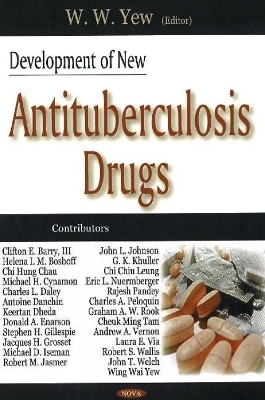
Development of New Antituberculosis Drugs
Nova Science Publishers Inc (Verlag)
978-1-59454-857-4 (ISBN)
In the global war to control tuberculosis (TB), there are several critical battles which must be waged and won if we are to make significant progress. Broadly speaking, these battlefields may be regarded as diagnosis, treatment and prevention. Within the arena of treatment are various critical elements. Current drug regimens require 6 months to achieve predictable cures; it is essential that shorter regimens be developed to lessen non-adherence and to improve affordability. To facilitate directly-observed therapy, intermittent (less than daily) regimens have been employed. To ensure favourable outcomes, including patients with AIDS, thrice-weekly regimens are the current standard; reducing the frequency of dosing to twice- or once-weekly may offer significant advantages. Drug resistance to the current major medications, the rifamycins and isoniazid, threatens to make tuberculosis untreatable for rising numbers of patients in many regions of the world. Finding new, effective agents is essential to ensure cures for these cases and to halt transmission of multidrug-resistant tuberculosis to others. Additional issues include reducing the side effects and toxicity of anti-tuberculosis regimens and developing regimens that can be given simultaneously with anti-retroviral therapy without deleterious drug-drug interactions or unacceptable toxicity. Finally, attention must be directed to the potential utility of treating latent infection to prevent the evolution of active disease. The current vaccine Bacille Calmette-Guerin (BCG), while protecting infants and children against potentially lethal forms of TB, has done little to control the incidence of communicable adult pulmonary disease. Research is underway to develop improved vaccines, but due to the prolonged period to determine the efficacy of a TB vaccine (a minimum of 10 to 20 years) -- alternative strategies must be pursued. Furthermore, the utility of a traditional vaccine would be sorely limited by the fact that roughly two billion persons today harbour latent tuberculosis infection. This huge reservoir of future disease would not be eligible for a traditional pre-infection vaccine. "Preventive therapy" with isoniazid has been shown to reduce the subsequent risk of tuberculosis by about 70% in large, randomised placebo-controlled clinical trials. However, this strategy is limited by the requirement for extended duration of treatment (6 to 9 months), the risks of drug-induced hepatitis and rising rates of resistance to isoniazid in many regions of the world where the TB epidemic is most intense. Alternative means for the treatment of latent tuberculosis infection should be given high priority. The authors have assembled an outstanding panel of contributors to address these issues. The topics herein have great relevance both in the industrialised nations where contemporary medications and strategies appear to have exacted their maximum benefits and for the developing nations where this ancient scourge remains rampant. This book will provide an impetus for authorities and organisations devoted to the development of new drugs to address the aforementioned growing problems of TB world-wide.
Preface; Global Control of Tuberculosis and New Drugs -- Public health aspects of new drug development for tuberculosis; Genomics in the Fight Against Mycobacterial Diseases; Target Selection to Shorten the Course of Tuberculosis Chemotherapy; Pharmacological Issues in the Development of New Antituberculosis Drugs; The Mouse Model in Evaluation of New Antituberculosis Drugs: Promise And Limitations; Surrogate Markers to Assess Clinical Efficacy of New Antituberculosis Drugs; Early Bactericidal Activity Studies: Promise and Pitfalls; Role of Clinical Trials in the Evaluation of New Anti-Tuberculosis Drugs; Current and Future Uses of Rifamycins in the Treatment of Pulmonary Tuberculosis; Fluoroquinolones in the Treatment of Tuberculosis: Current Status and Future Issues; Management of Latent Tuberculosis Infection Today and in the Future; Novel Delivery Systems for Antituberculosis Drugs; Immunology of Tuberculosis: Implications for the Development of New Therapies and Vaccines; Index.
| Erscheint lt. Verlag | 1.7.2006 |
|---|---|
| Zusatzinfo | Illustrations |
| Verlagsort | New York |
| Sprache | englisch |
| Maße | 260 x 180 mm |
| Gewicht | 846 g |
| Themenwelt | Medizinische Fachgebiete ► Innere Medizin ► Pneumologie |
| Medizin / Pharmazie ► Medizinische Fachgebiete ► Pharmakologie / Pharmakotherapie | |
| ISBN-10 | 1-59454-857-9 / 1594548579 |
| ISBN-13 | 978-1-59454-857-4 / 9781594548574 |
| Zustand | Neuware |
| Haben Sie eine Frage zum Produkt? |
aus dem Bereich


